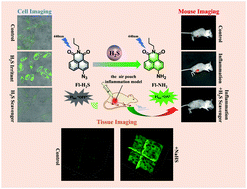Development of an activatable hydrogen sulfide-specific two-photon fluorescent probe for bioimaging in an air pouch inflammation model†
Abstract
Inflammation caused by traumatic, ischemic, infectious, autoimmune or toxic injury may further trigger cancer and even death. Overexpression of hydrogen sulfide (H2S) in vivo has been identified as a biomarker for various types of inflammation. Identification-responsive fluorescence imaging probes have broad application prospects for in vivo diagnosis of inflammation. However, it is a challenge to design an imaging probe that concurrently responds to the target molecules to improve the sensitivity and specificity of inflammation detection. Herein, we designed and synthesized an activatable two-photon fluorescent probe to detect H2S. Fl-H2S had high selectivity, excellent photostable signals and low detection limit for recognizing H2S. In addition, Fl-H2S showed excellent two-photon fluorescence properties in cell and liver tissue visualization experiments, with a penetration depth of up to 126 μm in liver tissue. Most importantly, the unique probe Fl-H2S was the first probe to monitor H2S levels in a mouse air pouch inflammation model by fluorescence imaging technology. We expect Fl-H2S to become an effective tool for longitudinal monitoring of inflammation, diagnosis of inflammation and prediction of underlying pathogenesis of related diseases by detecting H2S.



 Please wait while we load your content...
Please wait while we load your content...